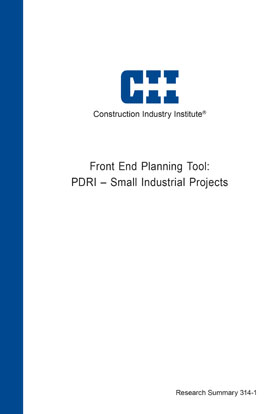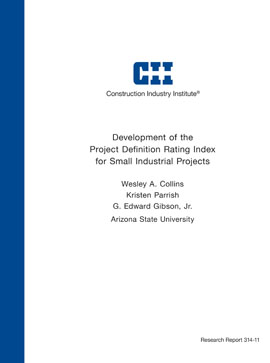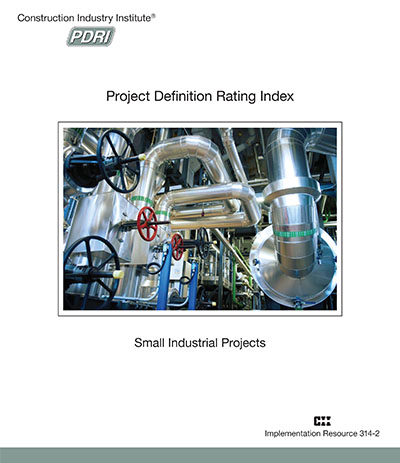
Front End Planning Tool: PDRI -- Small Industrial Projects
Past Construction Industry Institute (CII) research has found that tools that measure project scope definition and alignment among project participants are essential to facilitating good front end planning. These tools, developed by a number of research teams over more than two decades, help owners and contractors better meet their business, operational, and project objectives. While this earlier research addressed front end planning (FEP) for large industrial, building, and infrastructure projects, it did not focus on the unique challenges and characteristics associated with small projects, or more particularly, small industrial projects.
CII formed Research Team (RT) 314, Project Definition Rating Index for Small Industrial Projects, to identify obstacles to successful delivery of small industrial projects and to produce an effective, easy-to-use scope definition tool for these projects. This research summary provides an overview of the research and development of the PDRI–Small Industrial Projects (PDRI-SIP), the newest iteration of the PDRI tool, which is a cornerstone of the CII FEP Toolkit. The PDRI-SIP is a risk management tool that consists of 41 elements presented in a weighted checklist format. The tool provides a method for measuring the completeness of project scope development on small industrial projects. It is similar to the three other PDRI front end planning tools CII has produced: PDRI–Buildings; PDRI–Infrastructure; and PDRI–Industrial. It is a focused derivative of the PDRI–Industrial tool, quickly allowing project participants to assess the scope of small industrial projects. The tool’s weighted index, based on the input of 65 experienced projects planners, enables users to measure the level of scope definition and to compare scope definition to anticipated project success.
In addition to introducing the PDRI–SIP, this research summary also presents the research team’s findings on the efficacy of the tool, based on a data sample of small industrial projects. For this research, the team defined small industrial projects as those generally of less than $10 million (U.S. Dollars) in expenditure, of three to six months in construction duration, and of less overall complexity than large projects (based on several indicators discussed below). Small industrial projects annually comprise more than 70 percent of all completed projects by number in most organizations’ portfolios.
Users of the PDRI-SIP tool assess the level of scope definition of their projects, generating a weighted score for each that can reach up to 1,000 points—with a lower score being better. An analysis of 40 completed small industrial projects representing more than $150 million of constructed cost showed that projects scoring lower than 300 (out of the 1,000 total points) were significantly more successful that those that scored above 300. These projects saw 16 percent and 15 percent differences between average and targeted cost and schedule, respectively.
Also, eight different organizations used the PDRI-SIP tool on 14 projects during the front end planning process. Data from these projects showed that the tool provided the project teams with an understanding of risk and helped identify scope gaps. These exercises also proved the value, completeness, and capability of the tool, in each case helping project team members identify critical planning issues. The time needed to perform an assessment using the PDRI-SIP was typically 75 minutes or fewer (as opposed to 150 minutes typically needed for the other PDRI tools). These test uses further showed that the tool can improve front end planning of small industrial projects while reducing the time necessary to complete an assessment, and that it is fully ready for use. This summary provides guidance on how best to use the PDRI-SIP tool for project planning.



